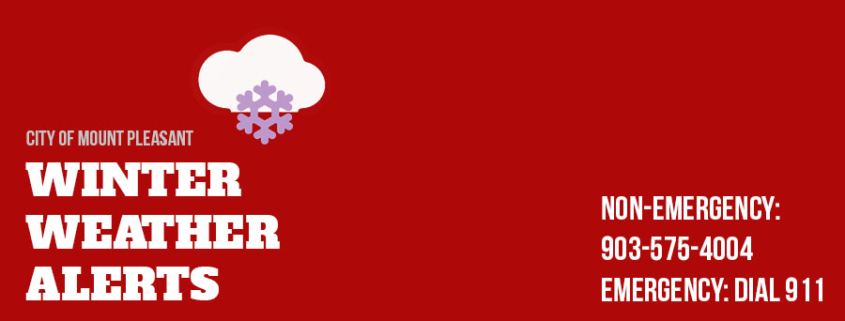Winter Weather Update
A Winter Storm Warning and Winter Weather Advisory are Now in Effect for Late Tonight through Thursday…
Timing and Overview:
Rain will transition to freezing rain across portions of Southeast Oklahoma, Northeast Texas, and Southwest Arkansas early Thursday morning. Precipitation could be heavy at times.
After daybreak, the precipitation will transition to a wintry mix of freezing rain, sleet, and snow, while gradually expanding eastward into more of East Texas and Southwest Arkansas.
Expected Accumulations:
- Snow
-Less than 1 inch for portions of Southeast Oklahoma, far Northeast Texas, and portions of Southwest Arkansas in the warning area.
-No significant accumulations for those areas within the Winter Weather Advisory. - Freezing Rain/Ice
-From one-quarter inch to almost a half an inch for areas in the Winter Storm Warning area.
-Up to a quarter of an inch for areas in the Winter Weather Advisory area.
Impacts:
- Ice is expected on all surfaces, making travel extremely dangerous to near impossible within the warning area.
- Elevated bridges and roadways will be at the highest risk across both the warning and advisory area..
- Isolated power outages could occur in the warning and advisory area due to ice on power lines and tree limbs.
PREPARE FOR WINTER WEATHER
Winter storms create a higher risk of car accidents, hypothermia, frostbite, carbon monoxide poisoning, and heart attacks from overexertion. Winter storms including blizzards can bring extreme cold, freezing rain, snow, ice and high winds.
A winter storm can:
- Last a few hours or several days.
- Cut off heat, power and communication services.
- Put older adults, children, sick individuals and pets at greater risk.
How to Protect Yourself from Winter Weather
IF YOU ARE UNDER A WINTER STORM WARNING, FIND SHELTER RIGHT AWAY
PREPARE
Know your winter weather terms:
Winter Storm Warning
Issued when hazardous winter weather in the form of heavy snow, heavy freezing rain, or heavy sleet is imminent or occurring. Winter Storm Warnings are usually issued 12 to 24 hours before the event is expected to begin.
Winter Storm Watch
Alerts the public to the possibility of a blizzard, heavy snow, heavy freezing rain, or heavy sleet. Winter Storm Watches are usually issued 12 to 48 hours before the beginning of a Winter Storm.
Winter Weather Advisory
Issued for accumulations of snow, freezing rain, freezing drizzle, and sleet which will cause significant inconveniences and, if caution is not exercised, could lead to life-threatening situations.
Know Your Risk for Winter Storms
Pay attention to weather reports and warnings of freezing weather and winter storms. Listen for emergency information and alerts. Sign up for your community’s warning system. The Emergency Alert System (EAS) and National Oceanic and Atmospheric Administration (NOAA) Weather Radio also provide emergency alerts.
PREPARING FOR WINTER WEATHER
- Prepare your home to keep out the cold with insulation, caulking and weather stripping.
- Learn how to keep pipes from freezing. Install and test smoke alarms and carbon monoxide detectors with battery backups.
- Gather supplies in case you need to stay home for several days without power.
- Keep in mind each person’s specific needs, including medication.
- Remember the needs of your pets.
- Have extra batteries for radios and flashlights.
- If you are unable to afford your heating costs, weatherization or energy-related home repairs, contact the Low Income Home Energy Assistance Program (LIHEAP) for help.
In Case of Emergency
- Be prepared for winter weather at home, at work and in your car.
- Create an emergency supply kit for your car. Include jumper cables, sand, a flashlight, warm clothes, blankets, bottled water and non-perishable snacks.
Keep a full tank of gas.
STAY SAFE DURING WINTER WEATHER
- Avoid carbon monoxide poisoning. Only use generators and grills outdoors and away from windows. Never heat your home with a gas stovetop or oven.
- Stay off roads if possible. If trapped in your car, then stay inside.
- Limit your time outside. If you need to go outside, then wear layers of warm clothing. Watch for signs of frostbite and hypothermia.
- Reduce the risk of a heart attack by avoiding overexertion when shoveling snow and walking in the snow.
- Learn the signs of, and basic treatments for, frostbite and hypothermia.
- Frostbite causes loss of feeling and color around the face, fingers and toes.
Signs: Numbness, white or grayish-yellow skin, firm or waxy skin.
Actions: Go to a warm room. Soak in warm water. Use body heat to warm. Do not massage or use a heating pad. - Hypothermia is an unusually low body temperature. A temperature below 95 degrees is an emergency.
Signs: Shivering, exhaustion, confusion, fumbling hands, memory loss, slurred speech or drowsiness.
Actions: Go to a warm room. Warm the center of the body first—chest, neck, head and groin. Keep dry and wrapped up in warm blankets, including the head and neck.

 2022 MPTX
2022 MPTX